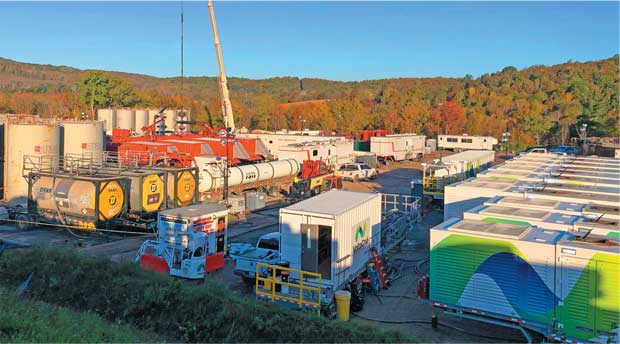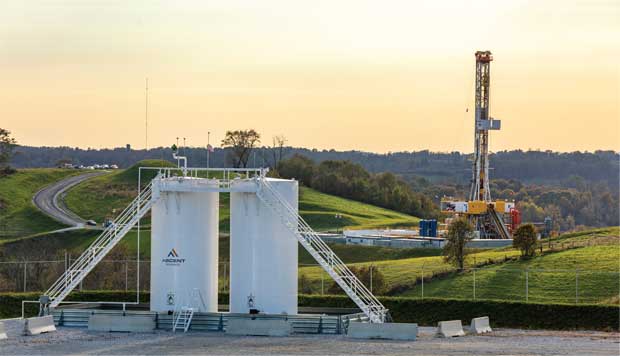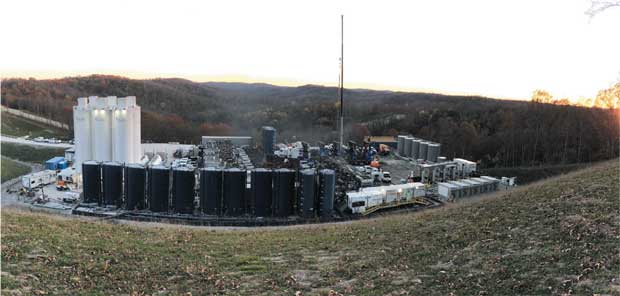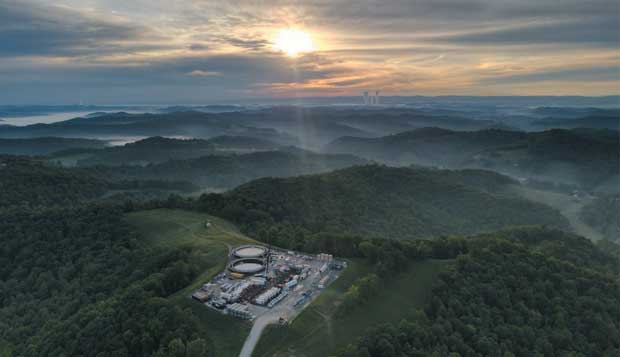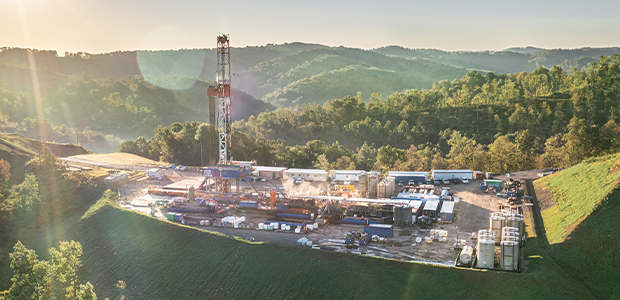
Appalachian Producers Build Toward Bright Future For Natural Gas Markets
By Danny Boyd, Special Correspondent
If the Appalachian Basin were its own country, it would rank as the world’s third-largest producer of dry natural gas. And with natural gas benchmark prices popping to the highest levels in years in both the U.S. and international markets, Appalachia is suddenly back in the spotlight as Old Man Winter prepares to come calling.
In late October, even before the official start of the winter heating season, November futures contracts were trading above $6/MMBtu on the New York Mercantile Exchange. And that was nothing compared with European and Asian markets, where prices repeatedly have set seasonal records during the past few months.
Bullish fundamentals, stronger market prices and precious pipeline capacity additions are welcome news for the operators that supply 34% of all U.S. dry gas from the Marcellus and Utica formations in Pennsylvania, West Virginia and Ohio. That list ranges from the powerhouse EQT Corp. to numerous large, mid-sized and small public and private independents, including Chesapeake Energy, Ascent Resources, Greylock Energy and Northeast Natural Energy.
Driven by the Marcellus Shale, Appalachian gas production soared to an historic high in October, averaging 34.8 billion cubic feet a day, according to the U.S Energy Information Administration. That was up by 1 Bcf/d year-over-year and effectively double 2016’s output. But despite the basin’s critical supply contribution, pipeline capacity growth has slowed in the wake of highly publicized project cancellations. After expanding from 4.5 Bcf/d in 2008 to 24.5 Bcf/d in 2020, pipeline capacity failed to increase in 2021 for the first time in several years. Help is on the way, however. The 2 Bcf/d Mountain Valley Pipeline is scheduled to enter service in 2022, connecting the Equitrans transmission system in northwestern West Virginia to the Transcontinental Gas Pipeline in southern Virginia.
Bright Future
Despite the challenges, the future of Appalachian gas is bright, especially considering the International Energy Agency’s estimate of a 50% increase in global energy demand by 2050, says Toby Rice, EQT’s chief executive officer. As the nation’s number one producer of natural gas, the company is producing 5.5 Bcfe/d or 2 trillion cubic feet equivalent annually.
Rice estimates that building new interstate gas pipelines to alleviate fragmentation in the domestic market and more liquified natural gas export facilities to supply global demand hubs will allow U.S. shale producers to add 20 Bcf/d of new supply in a relatively short period.
“That sounds like an ambitious goal, but when you look back 15 years, the industry nationally was producing just under 6 Bcf/d from shale formations. Now we are producing 70 Bcf/d from shales,” he points out. “The Appalachian Basin alone has added nearly 21 Bcf/d in production over the past seven years.”
EQT is focused on sustainable growth of its 25-year core of long-lateral, ‘combo’ development projects supported by advanced digital technologies, long-range well planning, and closely coordinated drilling and stimulation operations on multiple pads.
EQT has a 25-year core of long-lateral, “combo” development projects supported by advanced digital technologies, long-range well planning, and closely coordinated drilling and stimulation operations on multiple pads at the same time, Rice says. Given gas price dynamics, the company could easily ramp activity in the face of compelling economics, but is electing to keep its focus on “sustainable growth instead of chasing price signals,” he adds.
“Sustainable growth is securing long-term supply, pairing up long-term demand with long-term supply agreements, and then using those as vehicles to grow,” Rice remarks. “If the industry does it any other way and just grows production and throws the commodity on the market, we will end up in the same situation we saw in 2020 when gas prices were $2/MMBtu. I think operators are smarter now.”
Consequently, with industry investors heavily favoring free cash flow, deleveraged balance sheets, and zero-carbon footprints, Rice says EQT is continuing to maintain a “production maintenance mode” strategy on its 1.5 million acres in the basin. The company plans to drill a total of 1.2 million horizontal feet per year, with laterals averaging 12,000 feet per well. Its Pennsylvania Marcellus assets lead the way in low developed well costs among company holdings at $675 per completed foot of lateral, he offers.
Over the past two years, EQT has doubled drilling speeds and increased completion efficiencies by 75%, using gas-fired turbine “e-fleets” to stimulate wells with 2,000 pounds of sand and 2,000 gallons of water per lateral foot on average, according to Rice. EQT also is investing in water and logistics infrastructure to serve its footprint and further drive down costs.
Strategic Drivers
Consolidating and fully leveraging recent acquisitions, while simultaneously optimizing ESG performance, remain key strategic drivers for EQT, Rice states. Its purchase earlier this year of Alta Resources Development added 300,000 net northeast Marcellus acres, 1 Bcfe/d of current net production, 300 miles of midstream gathering systems, 100 miles of freshwater systems, and a firm transportation portfolio to premium demand markets, he summarizes.
That followed up EQT’s $735 million purchase of Chevron’s Appalachian assets in 2020. That deal included current net production of 450 MMcfe/d, 335,000 total net Marcellus acres (125,000 core net acres), 31% ownership of Laurel Mountain Midstream, and two water systems in Pennsylvania and West Virginia.
Even with its expansive operational footprint and its standing as America’s “largest pure-play natural gas producer,” Rice says the company plans to be net zero for Scope 1 and Scope 2 emissions by 2025. EQT has an initiative underway to spend $20 million to reduce emissions by eliminating more than 8,000 gas-powered pneumatic devices on its 3,000 Appalachia wells, he notes.
Already, the company has transitioned to electric frac fleets to eliminate more than 23 million gallons of diesel fuel from its annual operations and has entered into programs with Project Canary and Equitable Origin/MiQ to obtain ESG-related certification of natural gas produced from 200+ EQT well pads with output of approximately 4 Bcf/d, he reports. It also participates in the United Nations-sponsored Oil & Gas Methane Partnership 2.0 program to improve methane emissions reporting accuracy and transparency.
“Natural gas is the proven abundant, reliable, affordable and environmentally responsible energy source. The actions we have taken have set EQT on the path to be net zero by 2025, if not sooner. Bolstering this ambition is our ability to leverage technology and innovation to not only improve our operational efficiencies, but lessen our environmental impact,” Rice concludes. “Our efforts to certify our gas and participate in the OGMP 2.0 initiative demonstrate our commitment to transparency to our stakeholders. Through this, we aim to satiate both domestic and international demand for clean energy.”
Phenomenal Assets
Despite tight takeaway and a basis differential of about $1/MMBtu in mid-October, the Appalachian Basin remains a cornerstone asset for Chesapeake Energy Corp., which is spending 40% of its overall 2021 capital budget to develop its position on 540,000 net Marcellus acres in northeastern Pennsylvania, says Tim Beard, vice president over Appalachia operations.
“When it comes to allocating money, we will continue to focus a major portion of our capital and efforts on both the lower and upper Marcellus moving forward,” he says. “We are seeing wells in the 40 MMcf/d-60 MMcf/d range day in and day out when we turn these wells on line.”
The Oklahoma City producer plans to drill 65-75 wells this year on an acreage position that Beard considers the “core of the core” for both upper and lower Marcellus wells. Rates of return on lower Marcellus wells are in the 85%-100% range, with upper Marcellus wells yielding 75%-90% rates of return, he reports.
The Appalachian Basin remains a cornerstone asset for Chesapeake Energy Corp., which is devoting 40% of its 2021 capital budget to develop its 540,000 net Marcellus acres in northeastern Pennsylvania. The company expects to drill 65-75 wells this year on its high rate-of-return acreage position in the ‘core of the core’ for both upper and lower Marcellus formations.
Lateral lengths and well spacing are supporting well costs of $700-$750 per lateral foot, he assesses. Laterals average 9,000-10,000 feet with typical spacings of 1,200-1,400 feet between laterals, he explains. Completions include 2,000-2,500 pounds of proppant per lateral foot.
The company continues to keep an eye out for opportunities to add to tier one and tier two properties if deals are accretive to the company’s portfolio and its Marcellus development strategy in general, Beard relates.
“We are not going to overpay for an asset, or overpay to have an acquisition just for acquisition’s sake, even if it is the world’s best bolt-on,” he insists.
In the meantime, Chesapeake continues to upgrade production facilities to achieve net-zero direct greenhouse gas emissions by 2035. The goal is to reduce methane intensity to 0.09% and GHG intensity to 5.5 by 2025, Beard says.
Current efforts include eliminating routine flaring on all new wells completed from 2021 forward and companywide by 2025, replacing gas-powered pneumatic devices, and installing methane-sensing equipment on more than half its Appalachia pads, he details.
Chesapeake is working to achieve independent certification of its natural gas production under the MiQ methane standard and the EO100TM Standard for Responsible Energy Development, which covers extensive ESG criteria, Beard explains.
Holding The Line
Ascent Resources Utica Holdings LLC is focusing on capital discipline and generating free cash flow in an operational maintenance program targeting 2.0 Bcfe/d-2.2 Bcfe/d from its Utica acreage position in southeastern Ohio, says Chief Operating Officer Keith Yankowsky.
At its current pace, the Oklahoma City-based company has a 15-year inventory, he estimates, adding that it plans to hold the line for the foreseeable future to avoid adding more gas supply in the basin and eroding Appalachia’s already discounted price basis.
This year, Yankowsky reports that four rigs and one stimulation crew will support 60-65 new well spuds and 65-70 wells turned to production on Ascent’s 340,000-acre position, which includes nearly 80,000 mineral acres.
Ascent Resources Utica Holdings is running four rigs and one stimulation crew this year to support 60-65 new well spuds and 65-70 wells turned onto production on its 340,000-acre position. The company has cut cycle times on rig moves in half while doubling daily frac stage counts over past couple years.
Ascent replenishes about 50% of its developed acreage every year through its on-the-ground leasing program, with 87% of the position held by production. However, the company continues to keep an eye out for attractive acquisition targets in the basin and elsewhere, Yankowsky divulges.
“With our cost structure and operating ability, we are the premier operator and logical consolidator in the Utica, but that is not to say we do not look across the Lower 48,” he says.
In addition to longer laterals, efficiencies have been achieved from a deep top-hole rig program that strictly drills intermediate sections down to the curve before horizontal rigs drill the lateral, Yankowsky explains.
Cycle times on rig moves have been cut in half over the past couple of years, with well costs in the $550-$575 per lateral foot range ranking as the lowest in Appalachia, he says. A contiguous land position has allowed the company to steadily increase lateral lengths to 13,000-15,000 feet and achieve a record of 18,431 feet, according to Yankowsky. Ascent says it expects to drill a record lateral in the 23,000-foot range before the end of the year.
Dry gas well spacing is 1,000-1,250 feet with liquids-rich well spacings a little tighter at 800-1,000 feet, he explains. Frac designs include 1,300-1,400 pounds of sand and 25-30 barrels of fluid per lateral foot on dry gas wells and 1,500-1,550 pounds of sand and 30-35 barrels of fluid per lateral foot on liquids-rich wells.
Frac crews have gone from averaging 7.0-7.5 stages a day a few years ago to 15.5-16.0 stages a day, and the average daily stage counts continue to rise, Yankowsky points out.
The company has seismic data on 70% of its acreage to aid geosteering and drilling teams that have achieved 99% or greater success rate in steering laterals within the target zone, with a typical target of 20-25 feet.
Ascent continues to work to minimize emissions, replacing gas-powered pneumatics, which account for about 30%-40% of emissions, with air pneumatic devices on 170 total pads, Yankowsky reports.
The company also is working to reduce diesel consumption by using buy-back gas and CNG via dual-fuel systems. Ascent also is relying on longer laterals to reduce surface impact and truck traffic in the communities in which it operates. “Our goal is to use 100% of our produced water in our completion operations and we have sharing agreements with other operators to help us achieve this goal,” he comments.
Ascent also is working with the American Exploration & Production Council, The Environmental Partnership, and the ONE Future Coalition to drive improvements and reduce emissions, Yankowsky says.
Scaling The Business
Although Henry Hub futures were well above $5 in late October, futures prices were stuck in the low $3/MMBtu range out to 2023, notes Kyle Mork, president and CEO at Greylock Energy LLC. The longer-term price outlook uncertainty calls for a measured approach to planning, he says.
“You have almost a 50% reduction in strip prices going out less than two years, so the question for all of us is, ‘How is all of this going to settle out?’” Mork asks. “We are going to have to see what happens this winter, obviously. Of course, we all love to have higher prices going into winter, but where does it go from here?”
Launched in 2017 when ArcLight Capital bought assets of Energy Corporation of America, the Charleston, W.V.-based company has more than 4,000 Appalachia wells on 900,000 acres in eastern Kentucky, West Virginia and Pennsylvania. Although most wells are conventional, dry gas from the Marcellus accounts for 85% of current output, Mork remarks.
Greylock Energy operates more than 4,000 wells on 900,000 acres in eastern Kentucky, West Virginia and Pennsylvania. Although most of its wells are conventional, dry gas from the Marcellus Shale on its 110,000-acre position in Pennsylvania accounts for 85% of Greylock’s total production.
In Pennsylvania, where Greylock has about 110,000 acres, the company has expanded through initial leasing, acquiring acreage where leases have termed out, and through trades, he says. The company seeks new opportunities to add acreage and upstream and midstream operations over the next five to six years, Mork adds.
“While our team does a great job of operating the core business and executing that base plan, we are also highly active in the acquisition and divestiture market looking for opportunities to scale the business,” he says.
Meanwhile, Greylock continues on a steady pace of drilling up to 10 unconventional wells a year and operate within cash flow without having to source a lot of incremental capital, Mork explains.
Greylock is drilling longer laterals and pumping more sand per lateral foot. While lateral lengths beyond 10,000 feet are desirable, more complex geology and diffuse mineral acreage ownership can limit lengths to 8,000 or fewer feet, he explains.
Frac designs average between 2,500 and 3,000 pounds per foot on 200-foot stage spacing. EURs include an estimated 2 Bcf per 1,000 feet of lateral and total reserves of about 600 Bcf. The company’s net gas production is a little over 100 MMcf/d, Mork says.
From Greene County, Pa., Greylock is able to ship its gas to Columbia, Dominion and Texas Eastern pipelines, Mork points out.
The company continues to focus on reducing emissions, and has been able to reduce methane and total GHG intensity. “Just operating dry gas wells is helpful, but we continue over time to look at ways we can reduce any potential emissions,” Mork details. “”Obviously, with a dry gas system, any lost methane is lost revenue. It is to our benefit, both financially and environmentally, to ensure we do not have preventable methane leakage.”
Consistent Performance
Higher gas prices are a bonus, but Northeast Natural Energy continues to focus on a consistently performing drilling and completion program to drive returns in its operations on 500,000 gross Marcellus acres in Monongalia and Marion counties of West Virginia, says founder and CEO Mike John.
“Our mantra is about controlling costs and maintaining the efficiency that we have now around essentially a one-rig operation,” says John, a West Virginia native who launched Northeast in 2009.
Northeast Natural Energy is operating a one-rig program to drill 20-24 wells a year on 500,000 gross Marcellus acres in Monongalia and Marion counties of West Virginia straddling two gathering systems with access to the Texas Eastern pipeline system.
Backed by Metalmark Capital, the Charleston-based company is drilling 20-24 wells a year on a position that straddles two active gathering systems with access to Texas Eastern. Current takeaway capacity is accommodating 400 MMcf/d from 112 wells. The completion of the MVP Pipeline next year will provide even more marketing flexibility, John offers.
The company continues to gain efficiencies through longer laterals, now averaging about 18,000 feet, with well costs averaging $650/lateral foot on 10-well pads. Frac designs include 2,000 pounds of predominantly 100-mesh sand per lateral foot. Well spacing has transitioned to more than 1,000 feet from 750-foot spacings previously.
Building its position organically is a challenge, but John insists the company’s land department has become increasingly adept at navigating the intricacies of highly fragmented mineral ownership.
“Our drilling units will have north of 1,000 mineral owners in them, so it is blocking and tackling on the land side,” John comments. “One of thing that sets our team apart is our understanding of the severances in our area, which go back to the 1830s.”
In a concerted effort to curb emissions, Northeast has realized benefits from a trial project with U.S. Well Service that utilizes all-electric frac fleets, John says, and is taking other initiatives to improve its environmental performance.
Northeast expects to soon be certified as a responsible sourced gas producer under the standards of Equitable Origins. The company also is working with the MiQ organization.
To conserve natural resources, Northeast is reusing 20% of its flowback volumes for frac water and does water exchanges with neighboring operators.
For other great articles about exploration, drilling, completions and production, subscribe to The American Oil & Gas Reporter and bookmark www.aogr.com.








